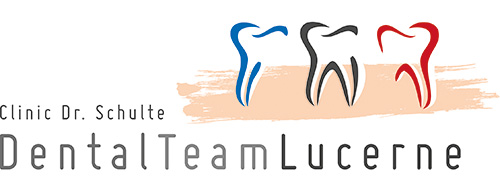Ceramic dental crowns and bridges
What is a dental crown?
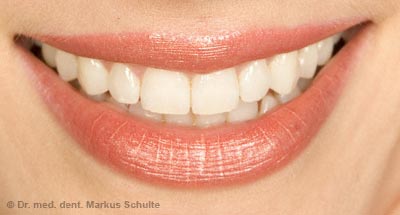
A dental crown is actually the visible part of a natural tooth that protrudes into the oral cavity. However, the term ‘crown’ is often used to refer to the crowning of a tooth. The dentist grinds (prepares) the tooth and takes an impression of the tooth stump. The dental lab then produces a tooth-shaped cover that fits the tooth stump exactly and completely surrounds and encloses the ground natural tooth. This coating restores the original shape of the tooth and can be adapted precisely to the neighbouring teeth in terms of shape and colour. The dentist checks the accuracy of fit and aesthetics of the crown and finally cements it onto the tooth stump.
When do you need a dental crown?
A crown is always indicated when a tooth is considerably weakened and reconstruction by means of a filling, inlay or veneer is no longer an option. This is particularly the case if:
- the defect (e.g. caries or old filling) reaches below the gum line
- the tooth is devitalised (has undergone root canal treatment); this applies in particular to the heavily loaded posterior teeth (premolars and molars)
- the tooth is deeply broken (fractured)
- caries or old fillings have spread around the tooth.
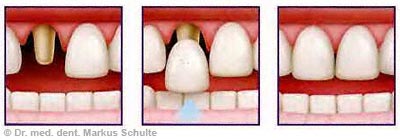
Ground tooth stump and attached crown on an incisor
However, a crown may also be necessary for aesthetic reasons if one or more teeth are severely discoloured, chipped or worn and conservative treatment with fillings no longer seems like a sensible course of action in the long term. Excellent and long-lasting aesthetic results can be achieved with the all-ceramic technologies available nowadays. In the case of smaller defects limited to the outer surface of the tooth, however, we prefer to use ceramic veneers, which enable much gentler preparation, as only the front of the tooth needs to be slightly ground down.
Case study: all-ceramic crowns

Total aesthetic and functional rehabilitation with all-ceramic crowns: This 52-year-old patient wanted total restoration because she was no longer satisfied with the aesthetic appearance of her teeth. Numerous old fillings, crowns and inlays had to be removed. The patient was extremely dissatisfied with her partially chipped and discoloured incisors from a cosmetic point of view. After a thorough examination and planning process, we decided to restore all of the teeth with all-ceramic crowns. Only the lower incisors underwent minimally invasive restoration with ceramic veneers, as there was still sufficient healthy tooth structure available. All of the work was carried out in a very light tooth colour according to the patient’s wishes (above: before; below: after treatment). You will find further sample images below.

There are three types of crowns and bridges in terms of material
- All-cast metal crowns: This crown, made entirely of gold or alloys, is rarely used today for aesthetic reasons (visible metal).
- Metal-ceramic crown, also known as a VMC crown (veneering metal-ceramic crown). Here, a metal core is covered (veneered) with ceramic on the outside.
- All-ceramic crowns without a metal core are the standard treatment today. The ceramic is translucent and enables good adaptation to the natural tooth colour.
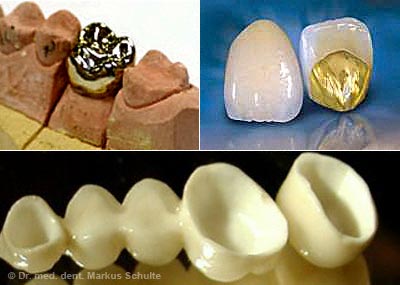
Top left: All-cast crown made of gold alloy Top right: Metal-ceramic crowns (VMC crowns) Bottom: All-ceramic crown and bridge
Metal-free all-ceramic crowns
Nowadays, it is possible to produce completely metal-free ceramic crowns and bridges that can withstand the stresses of masticatory pressure in every way. There is also no longer any need to grind down the tooth more than usual for ceramic crowns. The key word for this progress is zirconium. Ceramic frameworks made of zirconium dioxide (ZrO2), also known as zirconium, have extreme mechanical strength values and can compete with the hardest metals. The white zirconium framework is milled out of a block of zirconium using computer-controlled CAD/CAM milling equipment and then individually veneered with tooth-coloured porcelain. In addition to zirconium, lithium disilicate ceramic (Emax) can also be used for single crowns.
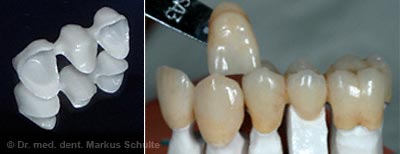
Left: Zirconium bridge framework. Right: Completely veneered work with colour sample
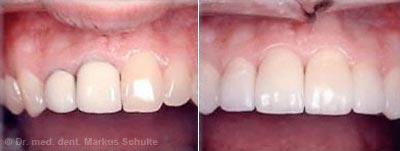
48-year-old patent: Incisors before and after treatment with all-ceramic crowns, as well as aesthetic harmonisation of the gum line at the same time
All-ceramic crowns are characterised by outstanding aesthetics, as not only do they reflect light, but they are also truly transparent (translucent), just like a natural tooth. This effect makes the porcelain crown particularly suitable for the anterior region, whereby minor corrections can also be made with respect to shape and position.

A comparison of the translucency (light transmission) of an all-ceramic crown (left) and a VMC (veneering metal-ceramic) crown (right) when illuminated with a light source
Another advantage of the metal-free design is the tooth-coloured crown edge, which does not necessarily have to be placed under the gums. This prevents irritation or recession of the gums caused by the crown edge.
Ceramic (porcelain) is an extremely biocompatible material that has no allergenic potential (i.e. it does not trigger allergies). This can be a real advantage for allergy sufferers.
Case studies from our practice

Aesthetic and biocompatible amalgam restoration with metal-free ceramic crowns
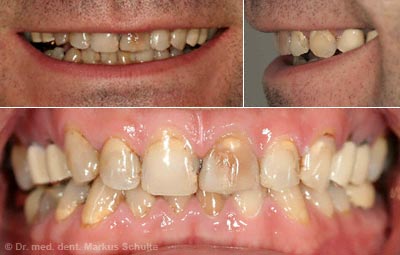
This 39-year-old patient approached us requesting a total restoration. All of the teeth were severely affected by caries, wear (abrasion) and defective fillings, and the bite had dropped (deep bite). The only way to achieve lasting restoration was by crowning all of the teeth. To make the sometimes long treatment sessions less stressful for the patient, we carried them out with additional nitrous oxide sedation, which the patient found extremely pleasant. Following aesthetic and functional rehabilitation with 28 all-ceramic crowns, the original bite height is restored (bite elevation).
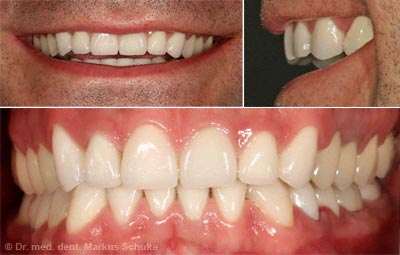
Left: Zirconium bridge framework. Right: Completely veneered work with colour sample
What is a pivot crown?
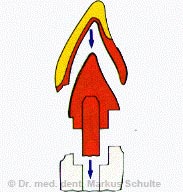
A pivot tooth or pivot crown is a crown that is anchored in the tooth’s root canal with a root canal post. This may be necessary to rebuild severely damaged teeth that have undergone root canal treatment. In the past, the root canal post, abutment and crown of pivot teeth consisted of one piece. Nowadays, a post made of ceramic, plastic or metal is cemented in the root canal and restored with a plastic abutment. The impression for the crown is then taken and cemented onto the abutment.
What is a dental bridge?
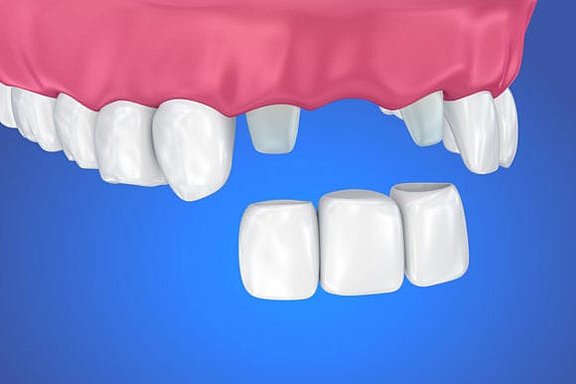
A dental bridge is a fixed dental prosthesis that is used when one or more teeth are missing and the gap is limited by teeth on both sides. To make the bridge, the neighbouring teeth are ground down (prepared) and an impression is taken over the tooth stumps. The bridge – consisting of two dental crowns (abutments) and the tooth in between (pontic) – is fabricated in the dental lab and then firmly cemented onto the tooth stumps.
In the past, bridges were the only way to replace missing teeth with fixed dentures. Nowadays, it is more common to close the gap with an implant, as there is no need to grind down the neighbouring teeth. But a bridge is still used in some cases (e.g. if the neighbouring teeth have to be crowned anyway).
What is a bonded bridge or an adhesive bridge?
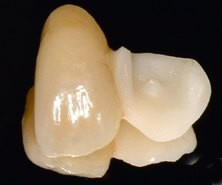
A bonded bridge (also known as a ‘Maryland bridge’ or an ‘adhesive bridge’) is bonded to the back of the neighbouring teeth with small ceramic or metal wings without having to grind the neighbouring teeth down. This particularly gentle method is suitable in many cases for small gaps in the front teeth or temporary restorations, and can sometimes also be an alternative to implants. However, if the ‘interlocking’ between the upper and lower teeth is too tight, there is sometimes not enough space for the adhesive wing, so this solution is then ruled out.
